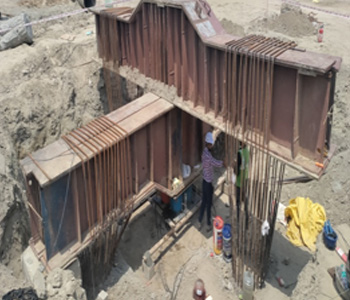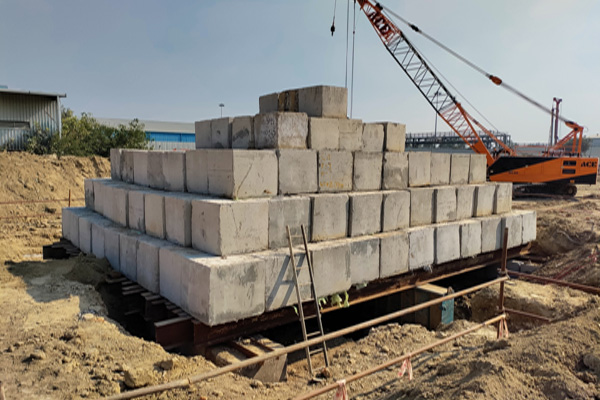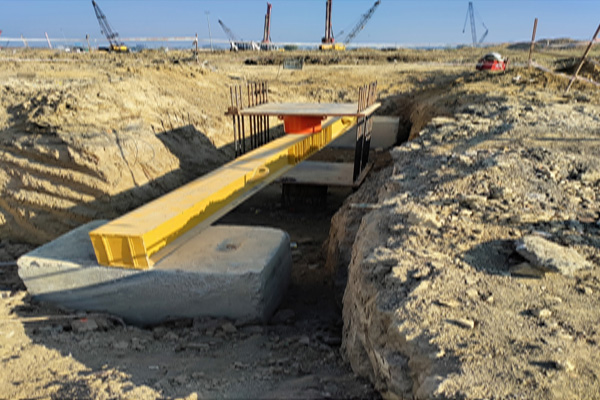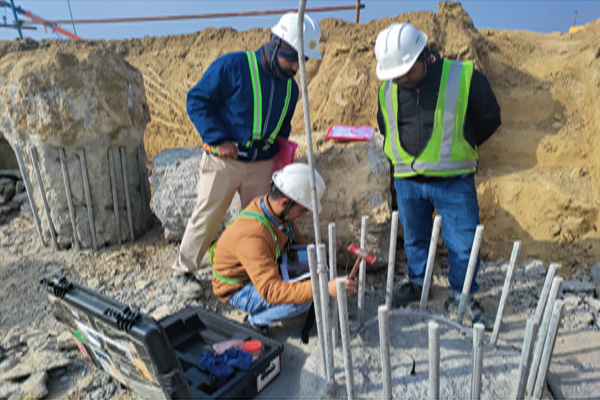



Pile Load Testing
Pile load testing play an important role in optimising the engineering, geotechnical and structural parameters of foundation not only in financial terms, but also with regard to sustainability. Therefore It is important to plan and execute the Pile Load Testing at an early and regular stages. The programme should allow sufficient time for an objective appraisal of the test results and subsequent design revisions/value engineering in any Project.
Pile load testing provides an opportunity for continuous improvement in foundation design and construction practices, while at the same time fulfilling its traditional role of design validation and routine quality control of the piling works. In order to achieve this improvement, data from pile tests has to be collected and analysed to enable the piling industry, both individually and collectively, to make the best use of resources.
1) Pile Static Load Testing
In this type of test, compression load is applied to the pile top by means of a hydraulic jack against rolled steel joist or suitable load frame capable of providing reaction and the settlement is recorded by suitably positioned dial gauges. There are two types of tests
(i) Initial Tests (ii) Routine Tests
Initial load test : This test is performed on test piles, i.e., constructed specially for testing purpose and will not be a part of structure, to confirm the design load calculations, and load applied for this test is 2.5 times the safe carrying capacity of the pile.
Routine Tests : Routine tests are carried on piles which are parts of structure and load applied on these piles is 1.5 times the safe carrying capacity of the pile.
There are two methods of applying loads on piles : first is by gravity or kentledge method in which a suitable platform is erected by sand bags or concrete blocks, and another method is by reaction method, in which load is applied to RSJ (Rolled Steel Joist or Girder) which are held by piles next to test pile.

2) Pile Dynamic Load Testing
This method is based on monitoring the response of piles subjected to dynamic hammer blows applied at the pile head. The measured response parameters are subsequently analysed to give predictions of the soil resistance that would be mobilised by the pile under static load conditions, based on stress wave theory. The analytical models of the pile/soil interaction have been further developed to provide prediction of the load/settlement performance of the tested pile. Developed initially for use with driven piles and now universally accepted, dynamic load testing of cast in place piles is now quite widely used to predict the static soil resistance and the load/settlement behaviour. The test method is similar to that used on driven piles with the monitoring of hammer blows and subsequently analysing the pile response to the stress wave propagation. A separate hammer or drop weight is usually brought to site to allow the dynamic load to be applied to a cast in place pile.


3) Pile Pull Out Testing.
In this type of test, Tension load is applied to the pile top by means of a hydraulic jack against rolled steel joist or suitable load frame capable of providing reaction and the settlement is recorded by suitably positioned dial gauges
There are two types of tests
(i) Initial Tests (ii) Routine Tests
Initial load test : This test is performed on test piles, i.e., constructed specially for testing purpose and will not be a part of structure, to confirm the design load calculations, and load applied for this test is 2.5 times the safe carrying capacity of the pile.
Uplift force is applied through jack resting on rolled steel joist of suitable strength resting on the two supports on the ground. The jack reacts acts as the reactions loading against the joist with a suitable frame attached to the reinforcement of the piles. The pile gets pulled up and the reaction transferred to the ground through the supports.

4) Pile Lateral Load Testing
1. This test is carried out by applying load laterally of successive increments as directed by the engineer in charge. The Load is applied in a series of lateral incremental load, each increment being of about 20 % of safe load on the pile. Once the incremental criteria are achieved, subsequently next incremental load is applied. The above process is repeated till the ultimate load or max allowable deflection (12 mm) is reached.
CRITERIA FOR THE LOAD INCREMENTS :-
Application of increment of test load and taking of measurement or deflection in each stage of loading is maintained till rate of deflection of the pile is 0.1 mm in 30 minutes or till 30 minutes whichever occur first. Each stage of unloading stage is to be maintained for at least 15 minutes and the subsequent rebound of the pile is measured by the dial gauges. If the limit of permissible deflection as given above is not exceeded, testing of pile is not required to be continued further.

5) Pile Integrity Testing
Low strain integrity testing requires the recording of the pile top acceleration caused by a blow of a hand-held impact device. Strains will be small, however, but acceleration can be measured by very sensitive motion transducers.
Low strain Pile integrity testing is a non-destructive and simple wave propagation method. It merely involves measuring the time and the characteristics for a compression wave to propagate axially through the shaft from the pile top to the pile tip and back to a receiver that is mounted at the pile top. The compressive wave is created by the blow of a hand-held impact device. In most cases a hand-held hammer is used. In this investigation, emphasis was placed on the verification of wave propagation velocity in concrete and the comparison with concrete strength data.
